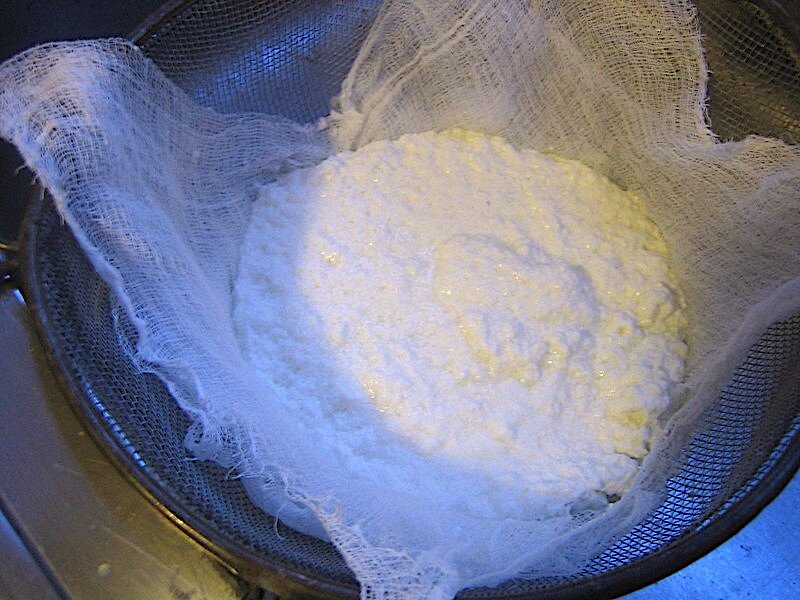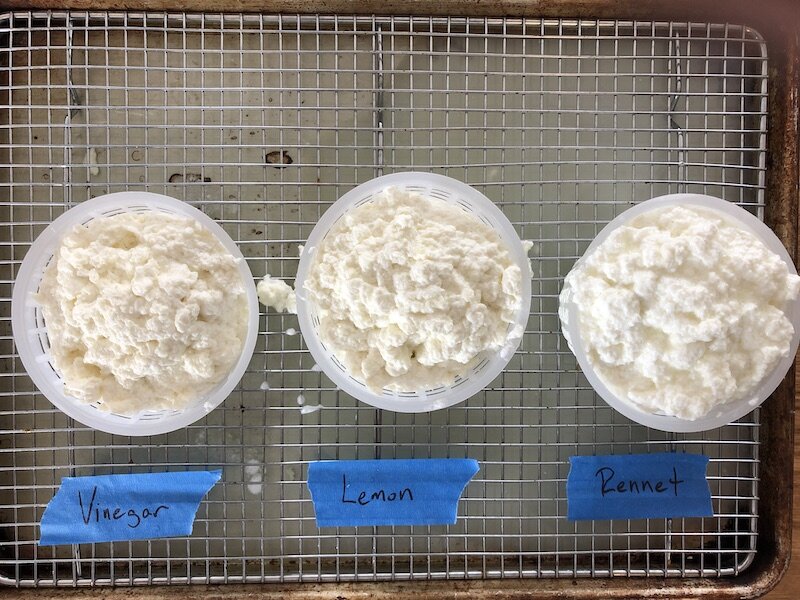The Secrets to Great Homemade Ricotta
"Making ricotta: step 3" by editrix is licensed under CC BY-NC 2.0
Homemade ricotta, when made well, is a revelation. It is lighter and fresher than mass-produced ricotta you can buy in a tub but sturdier than creamy, smooth ricottas (which are often made by pressing or smoothing the cheese with rollers). It has enough body to use in baked pastas but is delicate enough to eat on its own, the way you’d enjoy a thick yogurt. Best of all, you can eat it warm, which is a treat you’ll never get from a store-bought cheese.
Ricotta comparison photo credit: Georgia Freedman
You can make ricotta at home by using vinegar or lemon juice to acidify your milk or adding rennet to separate the curds from the whey. While all of these methods work well, the results are slightly different: Using rennet is more complicated than adding an acid—you have to carefully cool your cooked milk and add the rennet at exactly the right temperature—but the flavor is pure and slightly sweet. Adding vinegar is much simpler but leaves a slightly sour after taste in the finished cheese, while adding lemon juice leaves a lemony flavor (which can actually be lovely, depending on how you plan to use the cheese). Alternatively, you can add buttermilk to the milk before you heat it, which eliminates the need to mix in an extra ingredient at the end.
However you choose to acidify your milk, you’ll want to be gentle with the curd. “A lot of the home-cooking recipes will tell you to keep adding the vinegar, and keep stirring, until you get a clear whey. That process is just breaking the hell out of your ricotta,” says Liam Callahan of Bellwether Farms, which makes some of the country’s best ricottas. Instead, he says, you should do as little as possible to disturb the milk once the curds begins to set. Callahan also suggests adding a bit of cream to your milk. “The fat will help you overcome some of the errors in your process,” he notes. It also produces a creamier, more tender curd.
"Making ricotta: step 4" by editrix is licensed under CC BY-NC 2.0
The recipe below uses buttermilk instead of lemon or vinegar, because this method offers the best results for home cheese cooks. With buttermilk, you get a cheese that isn’t quite as sweet and flavorful as the ricotta made from rennet, but it is much easier to make and doesn’t have any of the residual flavors left by vinegar and lemon. Ricotta made with buttermilk also has the softest, most delicate curd, because you don’t have to mix anything into the milk after it has been heated, which can give it a rougher texture. This ricotta is great for a wide variety of uses. Stuff it into manicotti, use it to fill blintzes or cannoli, or just eat it in a bowl topped with some fresh fruit or a spoonful of flavorful jam.
Homemade Ricotta With Buttermilk
Ingredients
½ gallon whole milk
2 cups buttermilk
½ cup heavy cream
Special Equipment
Candy thermometer or instant-read
Slotted spoon
Draining basket or a sieve lined with cheesecloth
Put the milk, buttermilk, and cream in a medium-large pot and attach a candy thermometer or instant-read thermometer. Heat the milk gently, over medium heat, stirring occasionally, until you start to see small curds on the mixing spoon, at about 150° F. Stop stirring (so that you don’t disturb the curd too much), and let the milk continue to simmer until it reaches 175° F. (You can tip the pot back and forth a little while the milk is heating to see how the separation is going. You should see the yellow whey separating from the curd along the edges of the pot.)
Remove the pot from the heat, remove the thermometer, and let the pot sit, undisturbed, for 20 minutes, to let the curd start to firm up. While you’re waiting, put a draining basket or a cheesecloth-lined sieve on a cooling rack set into a rimmed baking sheet or a casserole dish that can catch the whey. Once the curd has set, use a slotted spoon to gently scoop the curd into the draining basket. (Some of the curd might be stuck to the bottom of the pot.) Let the ricotta drain to your desired consistency, about 10–20 minutes. Use immediately, or refrigerate for up to one week. (If you plan to refrigerate the ricotta, gently scoop it into an air-tight container, filling the space to the corners so that the cheese doesn’t continue to drain as it sits.)




